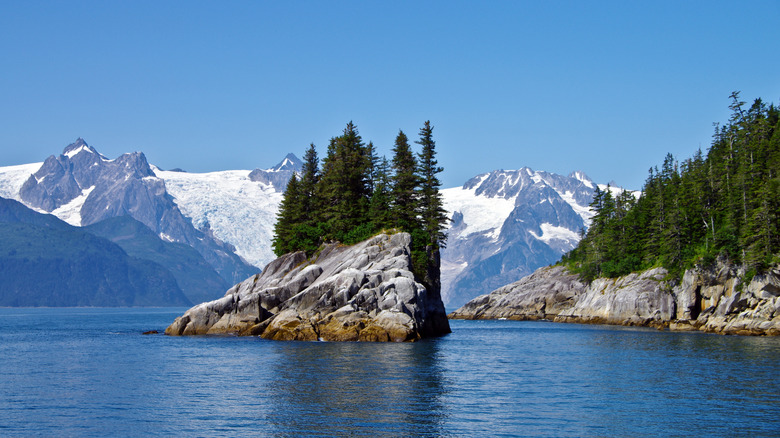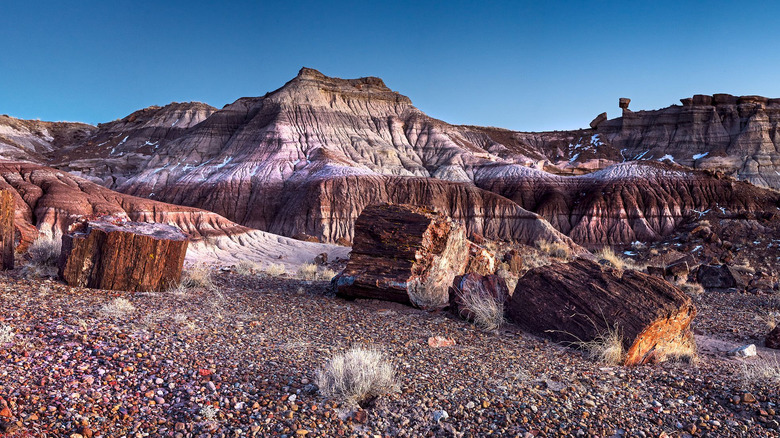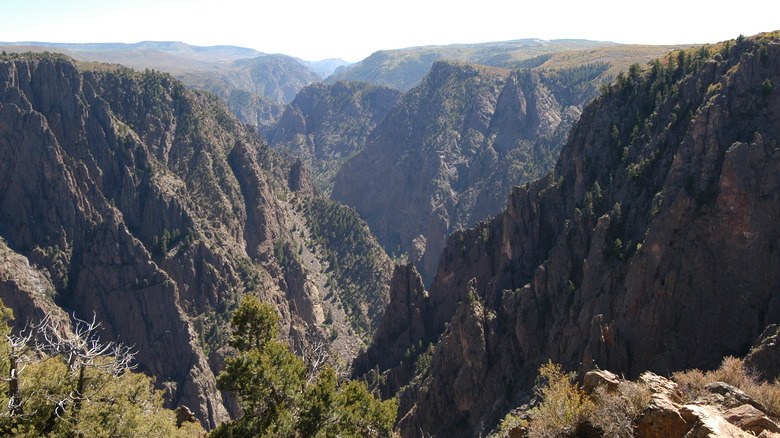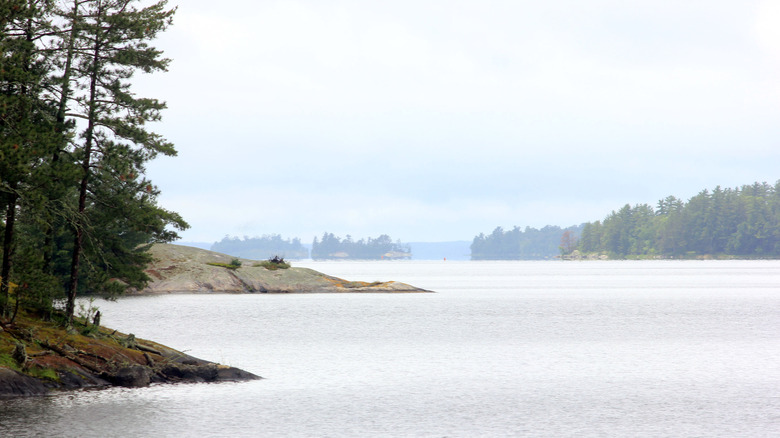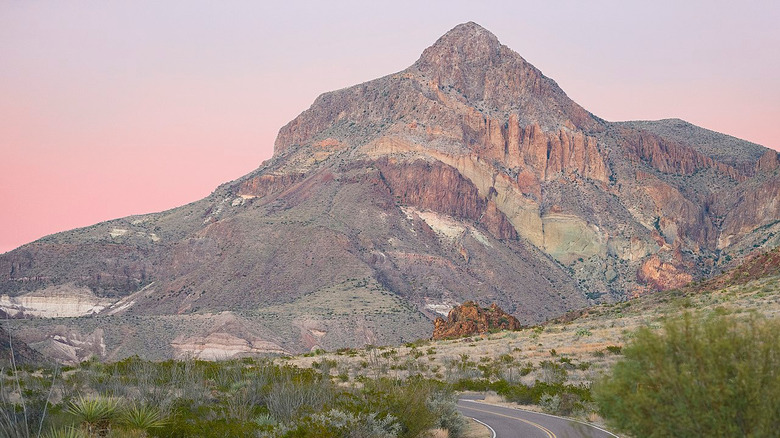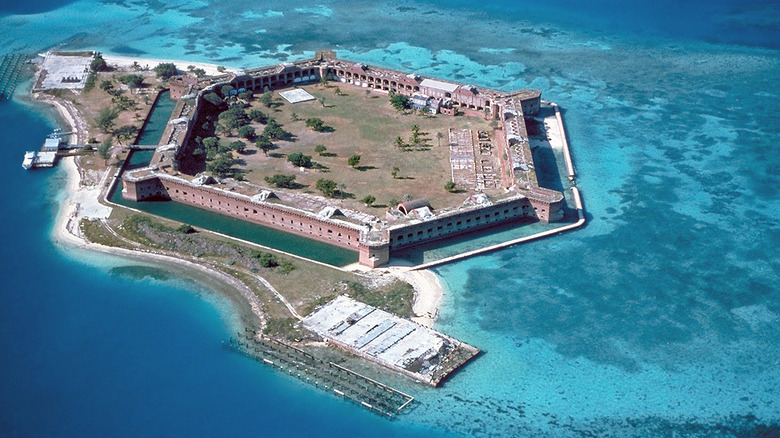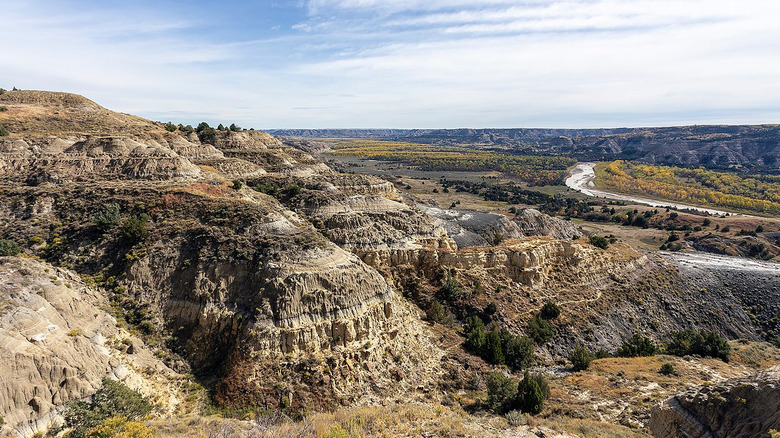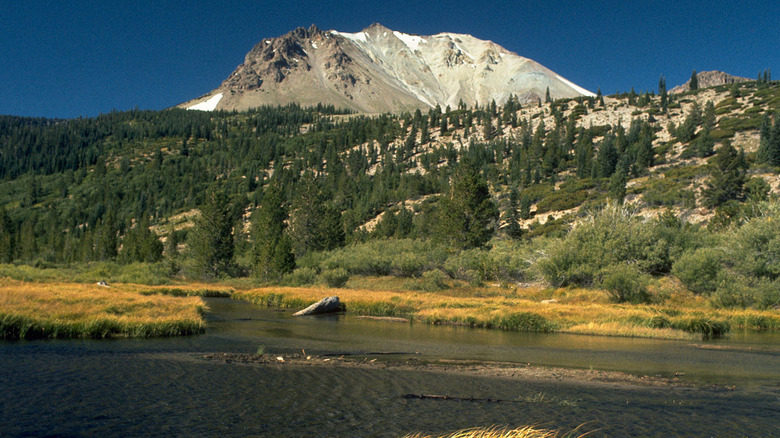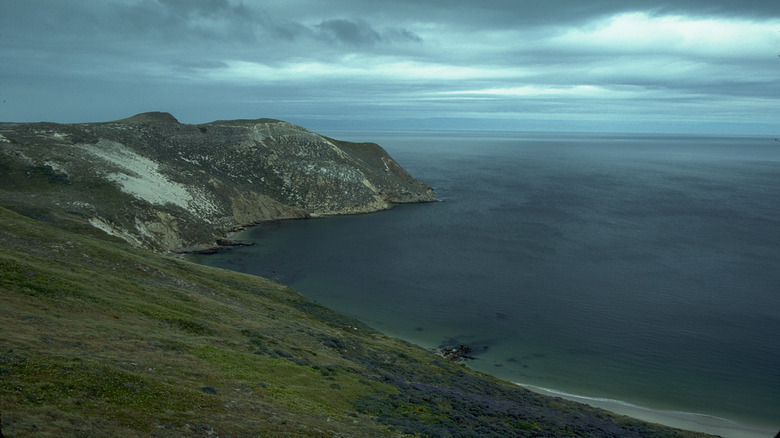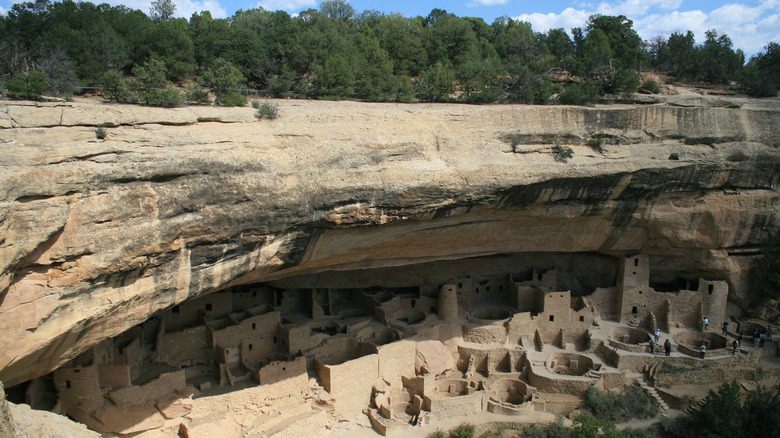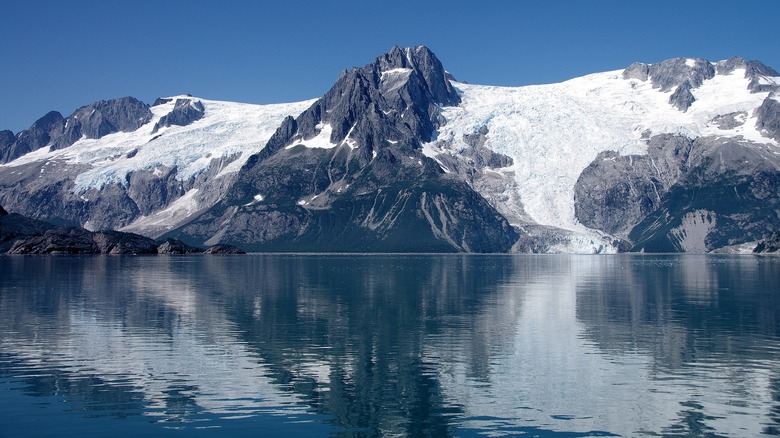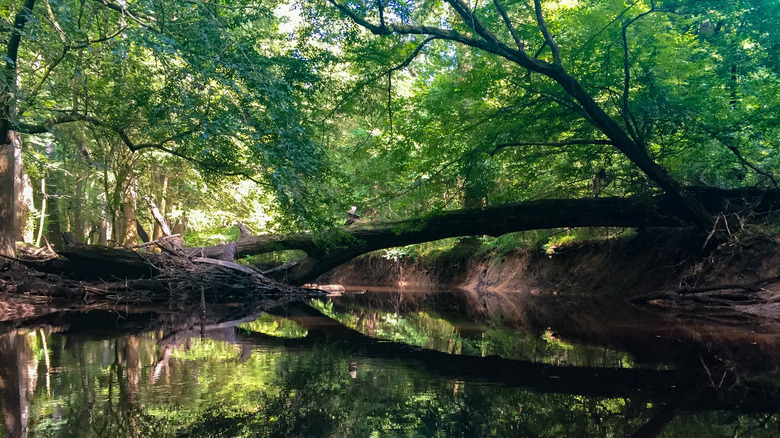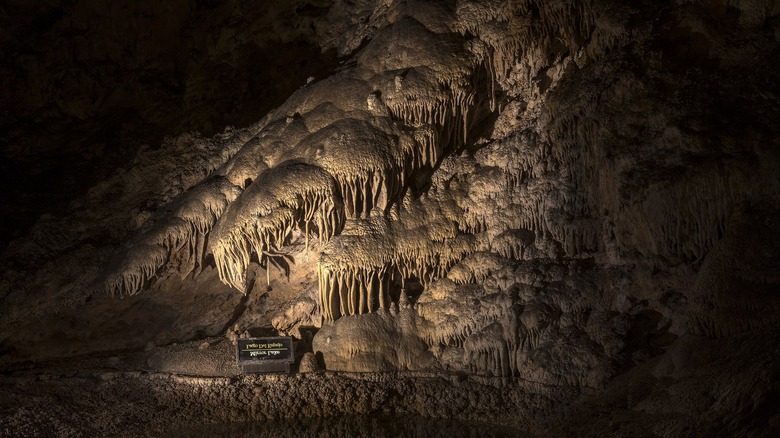The Most Underrated National Parks You Should Visit At Least Once
Some national parks get all the attention. If you've only briefly considered visiting such a place, chances are good that you've thought of one of the big ones, like California's Yosemite, the Western United States' Yellowstone, or Rocky Mountain National Park nestled in Colorado. Or maybe you think you're really going off the beaten path by considering Acadia in Maine or the Everglades in hot, humid Florida.
These are all fine choices, of course, but the reality is that there are more than 60 national parks in the U.S., according to the National Park Foundation. That number balloons to well over 400 if you consider all of the places under NPS jurisdiction, like national monuments, historic sites, and battlefields, to name but a few. With those numbers staring you in the face, it's clear that there are some parks we've all missed. They can't all be Yosemite-level famous, after all.
But just because something isn't well known doesn't mean it's not worth a visit. In fact, some of the less-considered national parks are truly hidden gems, with gorgeous nature, fascinating history, and much better parking. They may also offer an opportunity to explore your own locale since every state has at least one park, or historic site (via National Park Foundation). Who knows what sort of natural wonders and escapes from everyday life are within reach? These are the most underrated national parks you should visit at least once.
Petrified Forest
Though you may be forgiven for thinking you're in the midst of the Arizona desert when you visit Petrified Forest National Park, that's not entirely correct. According to the National Park Service, the main environments within the 200,000-acre park are either prairies or grassland, though they are in a very dry environment. What's more, Petrified Forest National Park is teeming with life, from the fastest mammals in North America (that would be the pronghorn antelope, per the National Wildlife Federation) to a rather lush array of mosses, cacti, and wildflowers.
Still, while you should definitely take the time to visit this national park for its rich biodiversity, you're probably still wondering about the name. What's up with this petrified forest business? True to its name, this national park is packed full of ancient trees that have been transformed into quartz fossils (via Petrified Forest National Park). If you're guzzling water in the arid landscape, it may be hard to believe that this was once the site of a series of rivers that watered trees across the region. The array of logs that have been preserved show that this was fact, though the forest flourished over 200 million years ago. There is so much you can enjoy, including the beauty and history of these colorful petrified trees and the many other fossils in this park.
Black Canyon of the Gunnison
Colorado is already pretty rich in natural beauty, what with the Rocky Mountains cutting a north-south line through the middle of things. It's also the state with the fourth-most national parks in the United States, according to WorldAtlas. Some of those parks are pretty well-known, like the majestic Rocky Mountain National Park, which showcases the state's unique high-altitude beauty, or Great Sand Dunes National Park, which not only holds the largest sand dunes in North America but will also let you sled down those same dunes.
But there's another national park that's unknown even to many Coloradans. That's a real shame because this hidden gem can also boast some seriously dramatic views. Only this time, your gaze will be going down — way down — instead of sky-high to the mountaintops. Welcome to Black Canyon of the Gunnison. As the name suggests, Black Canyon of the Gunnison National Park is centered on a dramatic canyon that cuts through the wilderness near Montrose, Colorado.
Not only are there geological delights and some serious hiking trails to enjoy, but Black Canyon is also an official International Dark Sky Park, meaning that campers and park employees work together to keep the skies as free of light pollution as possible. This means that, after a day of gawking at the beautiful sights and getting a hike or two in, you'll be treated to some of the clearest night sky views around (via National Park Service).
Voyageurs
Minnesota's Voyageurs National Park is crammed full of nature, with a rich ecosystem that visitors can explore via hikes, canoes, and overnight stays graced with a beautiful dark sky of stars overhead.
The park, so named for the French-Canadian voyageurs who spent their time traveling and trading through the region, was established in 1975 (via Britannica). Of course, the trappers weren't the first people in the region. According to the National Park Service, the earliest known humans, in what's now the park, were setting down roots about 10,000 years ago. There are hundreds of archaeological sites within the park that speak to the long history of Native Americans there.
Today, like the voyageurs of old, visitors can travel through the many waterways in the 341-square mile park, which include a series of scenic lakes. Look closely, and you may see one of the many wild animals that call the park home, from towering moose to deer, to beaver, and even wolves (via the Britannica).
Big Bend
If you want remote — and we mean well and truly off the beaten path, and then a bit farther than that for good measure — you'd be pretty satisfied with Big Bend National Park. Situated in rural southwestern Texas, this arid wonder includes not only a respectable chunk of the Chihuahuan Desert but also the entirety of the Chisos Mountain range (via Texas State Historical Association). If you want to see the spare beauty of the desert for yourself, then you're certainly in the right place. Besides the surprisingly varied natural environments within the park, the National Park Service also notes that you might encounter one of an estimated 75 mammal species, 56 different kinds of reptiles, and a staggering 3,600 species of insects.
If you're a dedicated history nerd, don't think you can pass this park by, either. The park has seen human activity for thousands of years, meaning you can see important archaeological sites and historic buildings all in the same park (via Big Bend National Park). Some of the people who made this land home included Comanche warriors, Spanish treasure hunters, and even farmers who made a go of it in the dry landscape.
Dry Tortugas
Dry Tortugas National Park is about 100 square miles in area, but not all of that is dry land. That's because Dry Tortugas is actually a series of seven small islands in the Atlantic, about 70 miles west of the Florida Keys. You'll have to hop on a ferry, or charter a seaplane, to get there. Once you've arrived, you can snorkel amongst the coral reefs. Don't expect any natural freshwater, though. The "dry" in Dry Tortugas means there's only saltwater around. The islands' few 19th-century inhabitants had to operate steam condensers to get fresh water, reports Smithsonian Magazine. Unfortunately, that also encouraged the proliferation of mosquitoes and yellow fever.
You'll want to check out historic Fort Jefferson on Garden Key. The monumental fort was built over three decades in the 19th century, according to the National Park Service. It was never finished, but remained a key military position near vital shipping routes, helping to secure the United States' interests in the region. It was also home to Dr. Samuel Mudd, the Civil War-era physician who treated John Wilkes Booth's broken leg after the latter had assassinated President Abraham Lincoln. As Smithsonian Magazine reports, Mudd was given a life sentence and exile in Dry Tortugas for treating the man, an act which Mudd said was required by medical ethics regardless of the patient's actions. After saving numerous lives during a yellow fever outbreak at Fort Jefferson, Mudd was granted a pardon in 1869.
Theodore Roosevelt
When it comes to states, much less national parks, we must admit that the Dakotas are pretty well ignored. When asked to imagine North or South Dakota, most surely envision either an endless prairie or a frozen wasteland a la the film and TV series "Fargo." But, of course, there's much more to the region than preconceptions fueled by an otherwise excellent Coen brothers movie (which is also largely set in Minnesota, anyway).
To help course correct this issue, plan a visit to North Dakota's Theodore Roosevelt National Park. It's not just named after the 26th president of the United States; according to National Geographic, a grieving Roosevelt retreated to this region after the deaths of both his mother and first wife on the same day. His namesake park was dedicated about a century later.
Though, as National Geographic notes, Roosevelt, the man, had a complicated relationship with race and land ownership, Theodore Roosevelt National Park allows you to acknowledge the original inhabitants of the land along with the natural beauty of the region. As per the National Park Service, the prairie and badlands that make up the park have been home to the Mandan and Hidatsa people, as well as other tribes that often moved through the region. Today, visitors can camp, hike, stargaze, and keep an eye out for the many animals in the park, including majestic bison.
Lassen Volcanic
So, you want to go to Yellowstone. Sure, if you've got the patience necessary to wend your way amongst the staggering numbers of tourists that visit this national park every year, go for it. We're not kidding. Yellowstone, which sits largely in Wyoming, saw nearly 5 million visitors in 2021, according to the National Park Service. But perhaps you'd like to still see some of the same fascinating geological features of Yellowstone, but without the headache of finding a parking spot or elbowing your way through a crowd of camera-wielding tourists.
In that case, we're going to let you in on something of a secret: Lassen Volcanic National Park. Located in northern California, it's quite a ways from Yellowstone, but it's still literally bursting with some of the same geological features, including mudpots, fumaroles, and, yes, volcanoes. In fact, according to the USGS, all four major types of volcanoes and represented within the park. Some of those are considered quite active, though take heart knowing that active seismic monitoring would give you plenty of warning before an eruption (via National Park Service).
Channel Islands
Some national parks require a fair amount of trekking to get there, whether it takes hours of driving or a special ferry crossing the waves. Yet, there are other national parks that are so close to major metropolitan areas that you'll be shocked they aren't more famous.
Channel Islands National Park is practically next door to Santa Barbara, California, and only a little further on lies the metropolis of Los Angeles. Granted, you can only visit this island group by boat, so getting there takes some extra planning beyond simply finding a parking spot and ambling into the visitor center. Yet, those who have visited will surely tell you that the experience is well worth the effort.
Why? For one, there are the stunning views of the surrounding Pacific Ocean, which is home to marine animals including seals, otters, sea lions, dolphins, and fish. If you're especially lucky, you'll spot a majestic humpback whale, too. As for things to do in Channel Islands National Park besides gazing in wonder about you, you can pick from a variety of hiking trails, campsites, and water activities like snorkeling and kayaking.
Mesa Verde
Now, Mesa Verde National Park has plenty of natural beauty. Travel to this spot in rural southwestern Colorado and you'll be treated to the spare beauty of the namesake mesas stretching off into the dry landscape (definitely remember to bring plenty of water on your visit here). Yet the real lure for many visitors here is the long-standing human history of the park.
That's because Mesa Verde is home to some truly impressive cliff dwellings. Though, as History Colorado reports, the park itself was founded in 1906, the human presence in the park goes much farther back. The Ancestral Pueblo people lived there from about A.D. 600 to A.D. 1200. Though their descendants live elsewhere throughout the southwestern United States today, the Ancestral Puebloans departed what's now the park, centuries ago. They left behind extensive settlements in dramatically-located cliff spots just beneath the mesas.
What caused the people to abandon their spot? According to High Country News, some nearby archaeological sites indicate violent encounters, with burned religious structures, and remains of people who met a violent end. Environmental factors like drought may have caused the instability. But, given the scarcity of written records for this place and time, we may never know for sure why Mesa Verde was abandoned. Regardless, you should visit the national park to not only take in the rich history of the region but to also tour the cliff dwellings and get an up-close look at what it was like to live there.
Kenai Fjords
With eight national parks, Alaska has the second-highest count in the system, after California's nine (via WorldAtlas). So, if you make it up there, or happen to live on The Last Frontier, you've got plenty of parks to choose from. But, while everyone's hoofing it up to Denali or Gates of the Arctic, perhaps you should pack up your kayak and check out Kenai Fjords National Park.
As the name strongly implies, this park is a coastal wonderland that's full of water-going activities, though the park's website strongly encourages kayakers to go with an expert guide. The waterways are largely open to the Gulf of Alaska, meaning that you might have to navigate choppy waters to gaze upon the glaciers that hang above the water.
If that seems a bit intimidating, rest assured that there are plenty of other activities within the park if your kayaking skills are a little rusty. There's the Harding Icefield trail that takes you on an 8.2-mile round trip that will give your body a real workout. If you want a more wintery experience, there are also plenty of cross-country skiing opportunities, along with snowmobiles. And if that's still a bit too much effort, you can always snag a boat tour out of nearby Seward for a more enclosed but still awe-inducing experience
Congaree
The National Park Service was officially established by the Organic Act of 1916, a piece of legislation that, despite the dull name, was a pretty big deal. According to the NPS, President Woodrow Wilson signed the bill into law, creating both the service and the Department of the Interior. In doing so, he wrote that the legislation's "purpose is to conserve the scenery and the natural and historic objects and the wildlife therein and to provide for the enjoyment of the same in such manner and by such means as will leave them unimpaired for the enjoyment of future generations."
That core value of conservation is important service-wide, but it may be especially obvious in South Carolina's Congaree National Park. The park is situated in a floodplain full of old-growth trees, making it one of the largest such expanses of wilderness in the United States. In a world that's increasingly full of development, from golf courses to shopping centers, the largely untouched wilderness of Congaree is truly something to behold.
If you're prepared to respect that natural environment, there's a lot for you to do in Congaree National Park, including plenty of kayaking and canoeing to see the park's unique biosphere up close. If you want to geek out a bit more, or simply want some background on the place as you guide a kayak through it, the USGS notes that there are millions of years of history to engage with in this 27,000-acre preserve.
Carlsbad Caverns
Listen, caves are pretty cool. If you're a little creeped out by the prospect of going underground into a pitch-black, dripping cave, we get it. But consider the fact that caves are unique ecosystems with fascinating animals, cool geology, and great history. If you need to reconsider your prejudice against caves — or, heck, even if you already love a bit of cave exploring now and then — then be sure to make your way to New Mexico's Carlsbad Caverns National Park.
As the name pretty strongly implies, the crown jewel of the park is the extensive cave system that lies beneath the surface of the New Mexico desert. The namesake Carlsbad Cavern is the best-known of the limestone caves, but not the only one. Believe it or not, the caves were formed about 265 million years ago when a large sea covered the area, leaving behind evidence of an ancient reef in what's now a parched landscape.
If the caves somehow aren't enough of an attraction to bring you out to Carlsbad, consider the many other things you can do in this national park. There are a number of aboveground hiking trails to enjoy, as well as stargazing and a unique bat flight program where you can witness Brazilian free-tailed bats entering or exiting Carlsbad Cavern while they're there in season. Just remember to keep your electronics out of sight. According to the National Park Service, the light and sound can disturb the bats when they're just trying to snag a tasty insect while taking to the skies.
